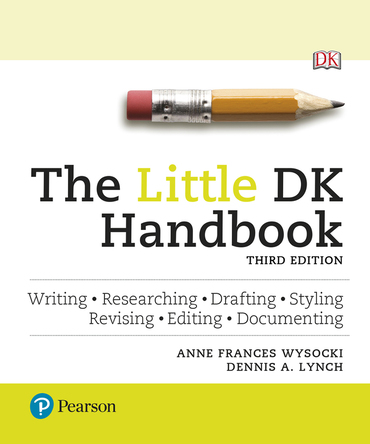1. A PROCESS FOR ACADEMIC COMPOSING
What is rhetoric?
What is composing?
A rhetorical process for composing
Understanding a project assignment
Composing in different academic genres
Academic composing...
2. FINDING IDEAS
A research process
Finding a general topic
Narrowing a topic
Questions to guide research
Kinds of research
Kinds of sources
Choosing sources
Periodical sources
Nonperiodical sources
Finding sources
Using your school's library catalog
Which search results best help your research?
Starting a paper: One student's process
3. EVALUATING AND TRACKING SOURCES ETHICALLY
Evaluating sources for RELEVANCE
Evaluating sources for CREDIBILITY
Evaluating sources for INTEGRITY
Why cite and document sources? Considering plagiarism and how to avoid it
The four facets of citing and documenting
Collecting citation information
From books
From periodicals
From webpages
From articles you find in a database of journals
Keeping track of sources: Starting a working bibliography
Hints and tips for collecting citation information
4. ENGAGING WITH AND ANALYZING SOURCES
Engaging with sources
Summarizing, paraphrasing, and quoting
Summarizing and paraphrasing others' words
Quoting others' words
Ways to use others' words and ideas well
An annotated bibliography: Summary and response
Putting sources in dialogue with each other
What is analysis?: About critical reading
Analyzing to understand
Identifying rhetorical strategies
Analyzing thesis statements
Using rhetorical analysis to understand
Analyzing to evaluate
5. ARRANGING A PROJECT
Using analysis to develop a thesis statement
Using a thesis statement to arrange an academic paper
Arranging paragraphs for audience and purpose
Unified and coherent paragraphs
Paragraphs that develop
Multimodal arranging: Visual texts
Multimodal arranging: Oral presentations
6. DRAFTING A PROJECT, CONNECTING WITH AUDIENCES
Understanding your audience
Developing a statement of purpose
Composing a first draft
A rough draft
Once you've finished a draft...
Receiving feedback to a draft
Responding to your peers' writing
7. REVISING WITH STYLE
Revising a project
Developing a revision plan
Styling paragraphs
Concluding paragraphs
Introductory paragraphs
Transitions between paragraphs
Passive voice
Styling sentences
Academic sentences
Sentences that are easy to read
Parallelism
Using coordination and subordination
Using inclusive language
Styling words
Multimodal style: Visual texts
Multimodal style: Oral presentations
Slides to support oral presentations
8. DOCUMENTING
MLA DOCUMENTATION
Guide to MLA Documentation Models
A Paper in MLA Format
A Works-Cited Page in MLA Format
MLA Documentation for In-Text Citations
Variations on the MLA In-Text Citation Pattern
MLA Documentation for Works Cited
"Stand-alone sources" and "Sources in containers"
Pattern: MLA Works Cited
Pattern: MLA Works Cited for Sources inside containers, inside containers
What sources need which elements
Figuring out a citation if there isn't a model
Element1: Author
Element2: Source Titles
Element3: Container Titles
Element4: Other Contributors
Element5: Version
Element6: Number
Element7: Publisher
Element8: Publication Date
Element9: Location
Citing sources when your project isn't a research paper
APA DOCUMENTATION
Guide to APA Documentation Models
Pages from a Paper in APA Format
A Reference List Page in APA Format
APA Documentation for In-text Citations
Variations on the APA Pattern for In-text Citations
APA Documentation for Reference List Entries
Pattern: APA References for Periodical Sources
Pattern: APA References for Nonperiodical Sources
APA References
Author's Name
Date of Publication
Place of Publication
Titles
Additional Information
Periodical Volume and Issue
For Online Texts
For Other Kinds of Sources
CSE DOCUMENTATION
Guide to CSE Documentation Models
CSE References: The Patterns
Details of the Patterns
CSE List of References
In-text Citations
Sample References
CMS DOCUMENTATION
Guide to CMS Documentation Models
CMS In-text Citations and Footnotes
Subsequent Note Entries
Bibliography
CMS Sample References
9. EDITING AND PROOFREADING YOUR WORK
Editing and proofreading
Making subject-verb agreement
Using verb tenses consistently
Using verb tenses in academic writing
Avoiding shifts in style and voice
Avoiding sentence fragments
Avoiding comma splices and fused sentences
Working with pronoun reference and agreement
Avoiding disruptive and dangling modifiers
Using apostrophes with possessive forms
Using articles conventionally
Using commas with introductory phrases
10. GRAMMAR, PUNCTUATION, AND MECHANICS
Grammar: Parts of Speech
Nouns
Pronouns
Adjectives
Articles
Verbs
Main verbs and helping verbs
Adverbs
Prepositions
Conjunctions
Grammar: Sentences
Sentence functions and patterns
Simple sentences
Subjects and predicates
Independent clauses
Compound sentences
Complex sentences
Compound-complex sentences
Punctuation
Commas
When not to use commas
Colons
Semicolons
Ellipses
Parentheses
Dashes
Brackets
Hyphens
Slashes
Quotation marks
Apostrophes
Periods
Question marks
Exclamation points
Mechanics
Using Italics and underlining
Spelling
Capitalizing words
Numbers
Abbreviations
Glossary
Index
Guide to Student Sample Work
Revision Checklist


 Instant access to eTextbook
Instant access to eTextbook
